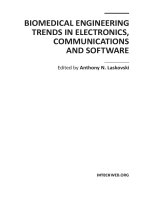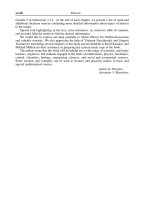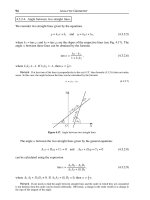Surface Engineering of Metals - Principles, Equipment and Technologies Part 1 potx
Bạn đang xem bản rút gọn của tài liệu. Xem và tải ngay bản đầy đủ của tài liệu tại đây (1.07 MB, 27 trang )
© 1999 by CRC Press LLC
© 1999 by CRC Press LLC
Preface
Surface engineering is a new field of science and technology. Although the
specific topical groups included in its domain have been known and prac-
tically applied in other areas, it is only in the last few years that surface
engineering has been recognized as an individual discipline of applied
science. This book is the first in the world to provide a complex treatment
of problems related to surface engineering.
The material of this book has been treated in two parts, so designed as
to allow extension in future editions.
Part I, devoted to general fundamentals of surface engineering, con-
tains a history of its development and a distinction is suggested between
superficial layers and coatings. Further, but foremost, the basic potential
and usable properties of superficial layers and coatings are discussed,
with an explanation of their concept, interaction with other properties
and the significance of these properties for the proper selection and func-
tioning of surface layers. This part is enriched by a general description of
different types of coatings.
Part II contains an original classification of production methods of
surface layers. This part presents the latest technologies in this field, char-
acterized by directional or beam interaction of particles or of the heating
medium with the treated surface. Due to its modest length, the book does
not discuss older methods which are well known and widely used.
This edition is a revised version of the first Polish edition of the book
entitled “Surface Engineering of Metals - Principles, Equipment, Tech-
nologies”, published by Wydawnictwa Naukowo-Techniczne (Science-Tech-
nological Publications), Warsaw, 1995.
The authors express their gratitude to all who in any way contributed to
the presentation of the broad array of problems of surface engineering in this
form. In particular, our thanks go to professors: J. Kaczmarek,
K.J. Kurzyd≈owski, R. Marczak, B. Ralph, J. Senatorski, J. Tacikowski and
W. W≈osiñski, as well as doctors S. Janowski, K. Miernik and J. Walkowicz
for their discussion regarding the book and constructive suggestions.
Special words of thanks are due to Dr. A. Mazurkiewicz, Director of
the Institute of Terotechnology in Radom, for his invaluable help in the
preparation of the work for print, and to the publisher, Wydawnictwa
Naukowo-Techniczne, for making information material from the first edi-
tion available. The authors thank Mr. A. Kirsz for expert technical assistance
for providing camera-ready text.
The authors
© 1999 by CRC Press LLC
Table of Contents
Part I. General Fundamentals of Surface
Engineering
1. The concept of surface engineering
1.1 The term ”surface engineering”
1.2 Scope of topics forming the concept of surface
engineering
References
2. Development of surface engineering
2.1 History of development of surface engineering
2.1.1 General laws of development
2.1.2 History of development of metallic structural
materials
2.1.3 History of development of the technology of
surface improvement of structural materials
2.2 Surface engineering today
2.2.1 General areas of activity of surface engineering
2.2.2 Significance of surface engineering
2.3 Directions of development of surface engineering
2.3.1 Perfection and combination of methods of
manufacturing of surface layers
2.3.2Design of surface layers, based on mathematical
modeling
2.3.3 Micro and nanometric testing
2.3.4Rational application of surface layers
References
3. The solid surface
3.1 The significance of the surface
3.2 The surface - geometrical concept
3.3 The surface - mechanical concept
3.4 The surface - physico-chemical concept
3.4.1 The phase
3.4.2 Interphase surface - a physical surface
3.4.3 Surface energy
© 1999 by CRC Press LLC
3.4.4 Surface phenomena
References
4. Surface layers
References
5. The superficial layer
5.1 Development of concepts regarding the superficial
layer
5.2 Shaping of the superficial layer
5.3 Structure of the superficial layer
5.3.1 Simplified models of the superficial layer
5.3.2 The developed model of the superficial layer
5.4 A general characteristic of the superficial layer
obtained by machining
5.5 Physical description of the superficial layer
5.6 Strengthening and weakening of the superficial
layer
5.7 Potential properties of the superficial layer
5.7.1 Geometrical parameters of the superficial layer
5.7.1.1 Three-dimensional structure of the surface
5.7.1.2 Surface roughness
5.7.1.3 Structural flaws of the three-dimensional
surface
5.7.2 Stereometric-physico-chemical parameters of
the superficial layer
5.7.2.1 Emissivity
5.7.2.2 Reflectivity
5.7.3 Physico-chemical parameters of
the superficial layer
5.7.3.1 General characteristic
5.7.3.2 Metallographic structure
5.7.3.3 Hardness
5.7.3.4 Brittleness
5.7.3.5 Residual stresses
5.7.3.6 Absorption
5.7.3.7 Adsorption
5.7.3.8 Solubility
5.7.3.9 Diffusion
5.7.3.10 Adhesion
5.7.3.11 Catalysis
5.8 Practically usable properties of the superficial
layer
© 1999 by CRC Press LLC
5.8.1 Strength properties
5.8.1.1 General characteristic
5.8.1.2 Fatigue strength
5.8.2 Tribological properties
5.8.2.1 Types of basic tribological properties
5.8.2.2 Types of friction
5.8.2.3 Sliding friction
5.8.2.4 Rolling friction
5.8.2.5 The role of surface in the friction process
5.8.2.6 Thermal effects of friction
5.8.2.7 Lubrication
5.8.2.8 Tribological wear and its various versions
5.8.2.9 Factors affecting tribological wear
5.8.2.10 Non-wear friction (selective carryover)
5.8.2.11 Limiting tribological wear
5.8.3 Anti-corrosion properties
5.8.4 Decorative properties
5.9 The significance of the superficial layer
References
6. Coatings
6.1 The concept of the coatings
6.2 Structure of the coating
6.3 Types of coatings
6.3.1 Division of coatings by material
6.3.1.1 Metallic coatings
6.3.1.2 Non-metallic coatings
6.3.2 Classification of coatings by application
6.3.2.1 Protective coatings
6.3.2.2 Decorative coatings
6.3.2.3 Protective-decorative coatings
6.3.2.4 Technical coatings
6.3.3 Classification of coatings by manufacturing
methods
6.3.3.1 Galvanizing
6.3.3.2 Immersion coatings
6.3.3.3 Spray coatings
6.3.3.4 Cladded coatings
6.3.3.5 Crystallizing coatings
6.4 Potential properties of coatings
6.4.1 Geometrical parameters of coatings
6.4.1.1 Thickness
6.4.1.2 Three-dimensional structure of the surface
© 1999 by CRC Press LLC
6.4.1.3 Surface unevenness
6.4.1.4 Defects of the three-dimensional structure
6.4.2 Geometric and physico-chemical parameters
of coatings
6.4.3 Physico-chemical parameters of coatings
6.4.3.1 General characteristic
6.4.3.2 Structure of metallic coatings
6.4.3.3 Residual stresses
6.4.3.4 Adhesion
6.4.3.5 Hardness
6.4.3.6 Ductility (elasticity)
6.4.3.7 Electrical properties
6.4.3.8 Magnetic properties
6.5 Service properties of coatings
6.5.1 Anti-corrosion properties
6.5.1.1 Types of corrosion
6.5.1.2 Corrosion resistance
6.5.1.3 Porosity
6.5.1.4 Bulging
6.5.1.5 Permeability
6.5.2 Decorative properties
6.5.2.1 External appearance
6.5.2.2 Color
6.5.2.3 Luster
6.5.2.4 Coverability
6.5.2.5 Specific decorative properties
6.6 Significance and directions of development
of coatings
References
Part II.
The newest techniques of producing
surface layers
1. Formation of technological surface layers
1.1 Techniques of formation of technological surface
layers
1.1.1 Mechanical techniques
1.1.2 Thermo-mechanical techniques
1.1.3 Thermal techniques
1.1.4 Thermo-chemical techniques
1.1.5 Electrochemical and chemical techniques
© 1999 by CRC Press LLC
1.1.6 Physical techniques
1.2 Classification of techniques of producing
technological surface layers
References
2. Electron beam technology
2.1 Advent and development of electron beam
technology
2.2 Physical principles underlying the functioning
of electron beam equipment
2.2.1 Electron emission
2.2.2 Thermoelectron emission
2.2.3 Utilization of plasma as a source of electrons
2.2.4 Acceleration of electrons
2.2.5 Electron beam control
2.2.6Vacuum in electron equipment
2.3 Electron beam heaters
2.3.1 Electron guns
2.3.1.1 Thermal emission guns
2.3.1.2 Plasma emission guns
2.3.2 Design of electron beam heaters
2.3.3 Types of beams and patterns
2.4 Physical fundamentals of interaction of electron
beam with treated material
2.4.1 Mechanism of interaction of electron beam with
treated material
2.4.2 Efficiency of electron beam heating
2.4.3 Rate of heating and cooling
2.5 Electron beam techniques
2.5.1 Remelt-free techniques
2.5.1.1 Annealing and tempering
2.5.1.2 Remelt-free hardening
2.5.2 Remelt techniques
2.5.2.1 Surface remelting
2.5.2.2 Alloying
2.5.2.3 Cladding
2.5.3Evaporation techniques
2.5.4 Applications of electron beam heating in surface
engineering
References
3. Laser technology
3.1 Development of laser technology
© 1999 by CRC Press LLC
3.2 Physical fundamentals of lasers
3.2.1 Spontaneous and stimulated emission
3.2.2 Laser action
3.2.2.1 Inversion of occupation of energy levels
3.2.2.2 Optical resonator
3.2.3 Single-mode and multi-mode laser beams
3.3 Lasers and laser heaters
3.3.1 General design of lasers
3.3.2Molecuar CO
2
lasers
3.3.2.1 General characteristic
3.3.2.2 Lasers with slow longitudinal flow (diffusion
cooled)
3.3.2.3 Lasers with fast longitudinal flow
3.3.2.4 Lasers with transverse flow
3.3.3Solid Nd-YAG lasers
3.3.4 Continuous and pulse laser operation
3.3.5 Laser heaters and machinetools
3.4 Physical fundamentals of laser heating
3.4.1 Properties of laser heating
3.4.2 The role surface absorption in laser heating
3.4.3 Depth of penetration of photons into the metal
3.4.4 Laser heating stages
3.4.5Temperature distribution in laser-heated material
3.4.6 Laser beam control
3.5 Laser techniques
3.5.1 Remelting-free techniques
3.5.1.1 Annealing and tempering, preheating
3.5.1.2 Remelt-free hardening
3.5.1.3 Surface cleaning
3.5.2 Remelting techniques
3.5.2.1 Surface remelting
3.5.2.2 Alloying
3.5.2.3 Cladding
3.5.3Evaporation techniques
3.5.3.1 Pure evaporation
3.5.3.2 Detonation hardening
3.5.3.3 Ablation cleaning
3.5.4 Laser techniques for formation of thin and hard
coatings
3.5.4.1 Coating formation by the fusion alloying in gas
method
3.5.4.2 Formation of coatings by the pure vapour
deposition method
© 1999 by CRC Press LLC
3.5.4.3 Pyrolytic and photochemical formation
of coatings
3.5.4.4 Formation of coatings by chemical methods
(LCVD)
3.6 Application of laser heating in surface
engineering
References
4. Implantation techniques (ion implantation)
4.1 Development of ion implantation technology
4.1.1 Chronology of development
4.1.2General characteristic of plasma and beam
implantation of ions
4.2 Plasma source ion implantation
4.3 Physical principles of ion beam implantation
4.3.1 Continuous ion beam implantation
4.3.2 Pulse ion beam implantation
4.4 Ion beam implantation equipment
4.4.1 Continuous ion beam implanters
4.4.2 Pulse ion implanters
4.5 Ion beam implantation techniques
4.6 Modification of properties of implanted
materials
4.6.1 Tribological properties of implanted materials
4.6.2 Strength properties of implanted materials
4.6.3 Hardness and adhesion of implanted materials
4.6.4 Corrosion resistance of implanted materials
4.6.5 Other properties of implanted materials
4.7 Application of implantation technology
4.8 Advantages and disadvantages of ion implantation
techniques
References
5. Glow discharge methods and CVD technology
5.1 Conception and development of glow discharge
methods
5.2 Physico-chemical basis of glow discharge
process treatment
5.2.1Glow discharge
5.2.2 Interaction between ions and metals
5.2.2.1 Ion sputtering
5.2.2.2 The role of ion sputtering in glow discharge
treatments
© 1999 by CRC Press LLC
5.2.3 Chemisorption in glow discharge treatments
5.3 Glow discharge furnaces
5.4 Glow discharge applications
5.4.1 Glow discharge nitriding
5.4.2 Glow discharge boriding
5.5 CVD methods
References
6. Vacuum deposition by physical techniques (PVD)
6.1 Development of PVD techniques
6.2 PVD techniques
6.2.1 General characteristic
6.2.2 Classification of PVD techniques
6.2.3 Discussion of more important PVD techniques
6.2.3.1 Techniques utilizing simultaneous evaporation
of substrate from entire liquid surface
6.2.3.2 Techniques utilizing local evaporation
6.2.3.3 Techniques utilizing direct sputtering
6.2.3.4 Techniques utilizing deposition from ion beams
6.3 Equipment for coating deposition by PVD
techniques
6.4 Coatings deposited by PVD techniques
6.4.1 Coating material
6.4.2Types of coatings
6.4.2.1 General
6.4.2.2 Classification of coatings
6.4.3 Control of structure and properties of coatings
6.4.3.1 General
6.4.3.2 Models of coating deposition
6.4.4 Preparation of substrate for coating deposition
6.4.4.1 Requirements to be met by the coated surface
6.4.4.2 Initial cleaning
6.4.4.3 Final (ion) cleaning
6.5 Service characteristics of coatings deposited
by PVD technique
6.5.1 General
6.5.2 Decorative characteristics
6.5.3 Tribological properties
6.5.3.1 Coating of tooling and machine parts
6.5.3.2 Tool performance
6.5.4 Anti-corrosion properties
6.5.5Optical and electrical properties
References
© 1999 by CRC Press LLC
part I
General Fundamentals
of Surface Engineering
© 1999 by CRC Press LLC
chapter one
The concept of surface
engineering
1.1 The term ”surface engineering”
The word engineering stems from the French language (s’ingenier - to con-
template, rack one’s brains, strain oneself, exert oneself) and in the past
had one meaning, while presently it has several meanings, all fairly close. In
the past it was a skill; presently it is mainly a science relating to the design of
shape or properties of materials and their manufacturing processes.
Originally engineering encompassed the art of building fortifications,
strongholds and other elements of defense systems. In 18th - 19th century
Europe we see the beginnings of differentiation between military and civil-
ian engineering. In more modern times the concept of engineering em-
braced the art of design and construction of all types of structures (with
the exception of buildings) and various engineering branches were distin-
guished: civil, hydro-, maritime, sanitary, forestry.
After World War II, the influence of Anglo-Saxon countries caused the
spread in Europe of the US - born concept of social engineering. Quite
recently, a new branch of science, termed environmental engineering, came
into existence.
It was also during this last century, especially after World War II, that
the term engineering was broadened to encompass some areas of human
knowledge, more particularly those connected with applied research, e.g.
the science of unit operations used in the chemical and related industries
and the subsequent development of chemical equipment (chemical engi-
neering), or the applied science drawing on the theoretical achievements
of genetics in the breeding of animals, cultivation of plants and in medi-
cine (genetic engineering).
Created and in use are such concepts as: biomedical engineering, elec-
trical engineering, reliability engineering, programming engineering, com-
munications engineering, aerospace engineering, process engineering, me-
chanical, ion beam, corrosion and other types of engineering.
The early 70s saw the importation from the US to Europe of the concept of
material engineering, created in the 60s and embracing the “scientific disci-
pline dealing with the investigation of the structure of materials, as well as
improvement and the obtaining of new materials with predicted and repro-
ducible properties.” (Scientific and Technical Lexicon, WNT, Warsaw 1984).
© 1999 by CRC Press LLC
Departments, chairs, institutes and even entire faculties of material engineer-
ing have sprung up.
It follows from the above definition that materials engineering deals with
the investigation of the structure of and the design of different materials,
including composites. It does not follow, on the other hand, although it can-
not be excluded, that materials engineering deals specifically with problems
of enhancement or modification of surface properties of materials.
It is probably due to this that the new term surface engineering
1
was coined
for the first time in England in the 70s. In the early 70s the Surface Engineer-
ing Society, affiliated with the Welding Institute in Abington, was inaugu-
rated. At first, it focused mainly on various aspects of welding and thermal
spraying and gradually it broadened its scope of interest. Next, the Wolfson
Institute for Surface Engineering was created at the University of Birming-
ham, initially concerned mainly with problems stemming from surface diffu-
sion treatments and their connection with vacuum technology, gradually
broadening the range of activity to other methods of formation of surface
layers.
The year 1985 saw the first edition of the quarterly “Surface Engineering”,
published by the Wolfson Institute for Surface Engineering jointly with the
Surface Engineering Society. As of 1987 another quarterly of a scientific-re-
search and technical nature was published under the same title, as the
combination of two periodicals: “Surfacing Journal International” and “Sur-
face Engineering”. This quarterly deals with thermal spraying technologies,
layer formation by PVD and CVD, electron and laser beam hardening, ion
implantation, shot peening, surface alloying by conventional and plasma
processes and generally with technologies of surface layer formation and
with some coating technologies. Problems of coatings, especially paint, plat-
ing and other types, are dealt with by other periodicals (e.g., “Surface and
Coatings Technology”, “Coatings”, “Metalloberfläche” and “Metal Finish-
ing”).
In October 1986, at the V International Congress of Heat Treatment of
Materials in Budapest, the name of the International Federation for Heat
Treatment of Materials, by then in existence for over 10 years, was changed
to International Federation for Heat Treatment of Materials and Surface
Engineering. For obvious reasons, both the Federation as well as Congresses
convened under its auspices prefer mostly problems connected with heat
treatment and, to a lesser degree, other problems connected with surface en-
gineering.
Over the past most recent years, many international conferences, meet-
ings and discussions devoted to surface engineering and its connections
with other fields of science and technology were organized.
1)
This term was later translated into French (l’ingenierie de surfaces), Russian (inzhinerya
poverkhnosti), and German (Oberflächeningenierie) but to this day used in these languages
only sporadically.
© 1999 by CRC Press LLC
1.2 Scope of topics forming the concept of surface
engineering
Surface Engineering is almost as old as structural materials used by man.
From the beginnings of time until the early 70s of our century, mankind has
worked on the development of surface engineering, although not aware of
the concept. The term of surface engineering, in use in the world for over ten
years, remained undefined and its topical scope is still the subject of discus-
sions, especially on the aspect of definitions.
In various ways, attempts have been made to define and to conduct a
broader discussion of selected problems of surface engineering, especially
those viewed through the techniques of formation covered by this scope
[1, 4]. Various book and handbook type publications presented different,
chronologically older technologies, within the scope of surface engineering.
There was a lack of publications dealing with the newest methods of manu-
facturing.
Earlier, generally the concept of surface enginnering was understood as
solely different techniques of forming superficial layers prior to the begin-
ning of service. Nothing was said about the formation of superficial layers
during service, about research and propertiers or about modeling of these
properties for concrete examples of application. Even newer literature does
not present a modern approach to the overall concept of surface engineering
[5, 6].
Today, such narrow understanding of surface engineering does not suf-
fice. In fact, this would be a far-reaching simplification. For this reason, it
was broadened during the years 1993-1995 to include problems of utilization
of superficial layers, as well as problems of their design [3, 4].
Based on research conducted since the 80s, as well as available scientific
and technical literature, the following topical scope and a definition of sur-
face engineering are proposed:
Surface engineering is a discipline of science, encompassing:
1) manufacturing processes of surface layers, thus, in accordance with the
accepted terminology - superficial layers and coatings, produced for both tech-
nological and end use purposes,
2) connected phenomena,
3) performance effects obtained by them.
Surface engineering encompasses all scientific and technical problems
connected with the manufacture of surface layers prior to end use or
service (technological layers) or during service (service-generated layers),
on or under the surface (superficial layers) or on a substrate (coatings),
with properties differing from those of the material which may be intro-
duced to the surface of the core in the form of gas, liquid or solid (Fig. 1.1).
It also includes research of connected phenomena and of potential and
usable properties of surface layers, as well as problems connected with
layer design.
© 1999 by CRC Press LLC
thermophysical, electrical, magnetic, adhesive, ablation, passivation, inhibition,
catalytic, biocompatibility, diffusion and others.
In the meaning as defined above, surface engineering has a lot in com-
mon with fundamental and applied (technical) science.
Surface engineering draws inspiration from (Fig. 1.2):
1) Fundamental sciences: physics, chemistry, partially mathematics and
constitutes their application to material surface;
2) Applied (technical) sciences:
– sciences dealing with materials science and material engineering, with
special emphasis on heat treatment,
– construction and use of machines, with special emphasis on material
strength, primarily fatigue, tribology and corrosion protection,
– electrical engineering, electronics, optics, thermokinetics, the science
of magnetism, etc.
The object of material science and material engineering - the material
constitutes the fundamental substance, the surface properties of which are
improved, enhanced and controlled by surface engineering. The knowledge
of material substrate or core structure is the basic condition of producing
layers on it. Methods of formation (producing) surface layers are included in
the area of machine building, as manufacturing methods.
The properties of surface layers produced are evaluated by methods
used in surface engineering, as well as in investigation and use of ma-
chines. These methods are used predominantly in areas such as: tribology,
corrosion protection, material strength, etc.
Some methods of designing of surface layer properties, used in surface
engineering, are also derived from - besides mathematics - material engi-
neering and machine building. This pertains primarily to material strength
and tribology.
The utilization of surface layers or their production during the course
of service belongs to the area of machine service and takes into account,
first and foremost, problems of tribology and corrosion protection.
References
1. Bell, T.: Surface engineering, past, present and future. Surface Engineering, Vol. 6,
No. 1, 1990, pp. 31-40.
2. Burakowski, T.: Metal surface engineering - status and perspectives of development
(in Russian). Series: Scientific-technical progress in machine-building. Edition 20.
Publications of International Center for Scientific and Technical Information - A.A.
Blagonravov Institute for Machine Science Building Research of the Academy of
Science of USSR, Moscow, 1990.
3. Burakowski, T., Rolinski, E., and Wierzchon, T.: Metal surface engineering (in
Polish). Warsaw University of Technology Publications, Warsaw, 1992.
© 1999 by CRC Press LLC
4. Burakowski, T.: A word about surface engineering (in Polish). Metaloznawstwo,
Obróbka Cieplna, Inzynieria Powierzchni (Metallurgy, Heat Treatment, Surface Engi-
neering), No. 121-123, 1993, pp. 16-31.
5. Tyrkiel, E. (General Editor), and Dearnley, P. (Consulting Editor): A guide to
surface engineering terminology. The Institute of Materials in Association with the
IFHT, Bourne Press, Bournemouth (UK), 1995.
6. Stafford, K.N., Smart, R. St. C., Sare, I., and Subramanian, Ch.: Surface engineer-
ing: processes and applications. Te chnomic Publishing Co. Lancaster (USA) - Basel
(Switzerland), 1995.
© 1999 by CRC Press LLC
part II
The newest techniques
of producing surface layers
© 1999 by CRC Press LLC
chapter one
Formation of technological surface
layers
1.1 Techniques of formation of technological
surface layers
In the overwhelming majority of cases, surface layers are formed before the beginning
of their service, by subjecting the object to technological treatment process - these are
technological surface layers. Only in exceptional cases are surface layers produced on
objects during service, e.g. layers formed during low wear friction - these are service-
generated surface layers. The following discussion relates to only the first kind of lay-
ers.
Depending on the type of effects utilized to form surface layers [1-8], all tech-
niques
1)
of formation may be generally divided into six groups (Fig. 1.1): mechani-
cal, thermo-mechanical, thermal, thermo-chemical, electrochemical and chemical,
and physical.
Each group of techniques allows the obtaining of a specific type of surface layer,
of given thickness and application and may be subdivided into many types. The
same types may be accomplished in different ways (Fig. 1.2).
Surface layers may be formed either by one technique (the most frequent case) or
by a combination of techniques (less frequent but fast growing) [3].
1.1.1 Mechanical techniques
In mechanical techniques, the utilized effect is the pressure of a tool or the kinetic
energy of a tool or particles (burnishing) in order to strain harden the superficial
layer of a metal or alloy at room temperature, or to obtain a coating on a cold metal
substrate. This is accomplished by: static burnishing, dynamic burnishing, explosive
spraying (deposition) and by machining [4].
1)
Te chnique (in this case: of formation of surface layers) - a combination of actions and means,
based on the utilization of same or similar effects, aimed at the accomplishment of a given
task, e.g. formation of a surface layer, strengthening of the superficial layer, deposition of
coatings.
© 1999 by CRC Press LLC
coating with properties different from those of the metal substrate, coupled with an
insignificant heating of the surface. Powders of coating materials - metals and their
alloys, chemical compounds of metals (oxides, carbides, borides), metal-ceramic
composites or ceramic - are usually finer than those used in thermal spraying. The
thickness of deposited coatings is usually 0.3÷0.4 mm, although in some cases may
even reach 1 mm. The application is similar as in the case of thermally sprayed
coatings but explosive sprayed coatings exhibit better properties.
Machining - a process which has, as its aim, the shaping of the object, its dimen-
sions and surface finish. Machining is usually accompanied by hardening of the su-
perficial layer, although it is not this effect but the obtaining of a desired surface
smoothness, that is the focus of surface engineering. Depending on the geometry of
the cutting tool, we distinguish:
– chip machining, accomplished by a tool with a defined number and geometry
of cutting edges, e.g. turning, milling, planing, slotting, etc.,
– abrasive treatment, accomplished by grains of an abrasive material with an un-
determined number of cutting edges and a random geometry,
– grinding (reduction of surface unevenness with the aid of grinding wheels or by
electric techniques: EDM, electrocontact, electrolytic), polishing (reduction of sur-
face unevenness, usually following grinding, by soft abrasives, blasting by abrasives
in a stream of liquid or by loose abrasives in the form of pellets), etc.
1.1.2 Thermo-mechanical techniques
Thermo-mechanical techniques utilize the combined effects of heat and pressure in
order to obtain coatings or, less frequently, of superficial layers. The techniques used
are [4]: spraying, plating, explosive hardening and plastic deformation.
Thermal spraying - coating of different objects (usually metallic) with a layer of
coating material, by pneumatic dispersion of tiny particles in a flame (usually gen-
erated by gas, electric arc or plasma), giving them velocity (even supersonic) in air,
vacuum or protective atmosphere, and kinetic energy. This energy assures the exer-
tion of pressure on the coated surface, allowing good adhesion of the sprayed coat-
ing to the substrate, with simultaneous heating up of the substrate to low tempera-
tures (not exceeding 150ºC). Coating materials usually applied by this technique are:
alloy steels, zinc, aluminum and its alloys, copper, tin, lead, nickel, brass, cadmium,
bismuth, cobalt, chromium, tungsten, titanium, molybdenum, composites of Ni-Cr,
Co-Cr, Ni-Al, Pb-Zn, tungsten carbides, Al
2
O
3
and TiO
2
oxides, and synthetics. Layer
thickness ranges from 50 to 1000 µm. Thermally sprayed coatings are applied mainly
for the protection of machinery and steel structures against atmospheric and gas
corrosion.
When metals are used as the coating material, the process is called spray metalli-
zation. Sprayed coatings may be subjected to heat treatment.
© 1999 by CRC Press LLC
Spray padding - spray deposition of a metallic layer on a metallic substrate by
means of welding, i.e. by surface melting of the substrate and the binder of a compo-
sition similar to that of the substrate. The bond between the molten layer and the
substrate is of a metallurgical nature. Spray padding is carried out in order to restore
or to improve tribological or anti-corrosion properties.
Plating - the coating of the substrate metal by another metal or alloy, sometimes
with the use of intermediate layers - by means of exerting pressure on the coating
material at an appropriately elevated temperature. We distinguish: static plating (e.g.
rolling, pressing, burnish broaching), detonation and shrinkage plating (e.g. utiliz-
ing casting shrinkage). Plating materials most often used are: aluminum and its al-
loys, bismuth, steels containing chromium, nickel or both, tool steels, copper and its
alloys, precious metals, Monel metal, Hastelloy, Invar, molybdenum and its alloys,
brasses, niobium, nickel, tin, tantalum and titanium. Coating thickness varies within
a broad range from several micrometers to several millimeters. Plating is used mainly
for the purpose of enhancing resistance to atmospheric and gas corrosion at elevated
temperatures and in chemically aggressive environments. In less frequent cases, they
may be used for the enhancement of tribological, electrical and thermal properties
or for decorative effects.
Hardening by detonation - hardening of a metal or alloy by a shock wave created
by sudden evaporation of substrate material when acted upon by a strongly concen-
trated stream of electrons (electron beam hardening) or photons (laser beam hard-
ening) with a rise of substrate temperature or detonation of an explosive mixture
(explosive hardening). This type of hardening is, basically, still in the stage of labora-
tory research.
Plastic deformation - a process aimed at shaping or division of the treated mate-
rial, effecting changes of its physico-chemical properties, structure and surface
smoothness, and the creation of residual stresses. Depending on temperature, we
distinguish:
– hot deformation - accomplished at temperatures at which recrystallization of
the treated material takes place,
– cold deformation - accomplished at temperatures at which recrystallization does
nor occur but only reduction and strain hardening (this process belongs to the me-
chanical, techniques group).
Depending on the type of deformations taking place, we distinguish:
– rolling - when the material is plastically shaped between turning rollers,
– forging - when the material, in the form of a block, is plastically shaped by
reduction, blows by a hammer or swaging machine, or by static pressure exerted by
a press. Modifications of forging are: extrusion, drawing and pressing.
© 1999 by CRC Press LLC
1.1.3 Thermal techniques
Thermal techniques employ effects connected with the influence of heat on
materials, and are aimed at [1÷8]:
– changing the microstructure of metallic materials in the solid state
(hardening, tempering, annealing),
– change of state of aggregation,
– transition from the solid to the liquid and again to the solid state of a
metal material of the substrate (partial melting or melt surfacing) or coat-
ing (pad welding, building up),
– obtaining a solid metal out of powdered coating material by melting,
– transition from the liquid to the solid state of the coating material
(hot dip cladding and coating).
Hardening, tempering, annealing - involves changes of microstructure
of the metallic material (in most cases of steel) in the solid state, in order to
obtain desired changes in mechanical, chemical and physical properties of
the superficial layer, without changes of the chemical composition. These
processes are accomplished by induction, flame, plasma, laser, electron beam
and resistance heating, followed by cooling or quenching at a required rate
[9].
Melt surfacing - the smoothing of a surface of metal or sealing of a metal
or non-metal coating, alternately obtaining of an amorphous structure (metal
glass) of the melted layer with physical chemical properties different from
those of the core, but without changes to chemical composition. Obtaining
of an amorphous structure (vitrification) is possible only with extremely
rapid heating and equally rapid cooling (called splat-cooling). This process
is accomplished with laser beam, electron beam, plasma and flame heating
[9].
Pad welding - a modification of surfacing, accomplished with the use of
welding torches, for overlaying of the metal substrate with a layer of alloy
material in order to obtain a coating with properties either:
– similar to those of the substrate to replenish worn material (repair)
– different to those of the substrate to enhance service life.
Pad welding causes some insignificant melting of the substrate material,
allowing a metallurgical bond between the substrate and the coating. Pad
welding is carried out with the utilization of welding techniques, mainly arc
and flame (oxy-acetylene) heating. Materials used for pad welding and for
the generation of coatings with special properties are: carbon and low alloy
steels, austenitic high manganese and chromium-nickel steels, chromium and
chromium-tungsten steels, high speed steels, high chromium cast irons, al-
loys such as Co-Cr-W, Ni-Cr-B, Ni-Mo and sintered carbides. The thickness
of pad welded layers usually reaches several millimeters. In the past. Pad
welding was considered a modification of plating.
Melt coating - utilization of laser beam, electron beam, spark discharge (also
with a ultrasounds participation) heating to deposit a coating composed of metal
(e.g. Al, Ni, Si), metal alloys (e.g. Cr-Ni, Cr-B-Ni), intermetallic com-
© 1999 by CRC Press LLC
pounds (borides, nitrides, carbides), ceramic (stellite) or metal ceramic, on the
surface of a metal or alloy, the properties of substrate and coating being differ-
ent from each other. These are usually coatings featuring heat resistance,
acid and corrosion resistance, as well as resistance to high temperature ero-
sion. As an example, cobalt alloys may be coated by nickel alloys to obtain
corrosion resistant superalloys while aluminum-silicon alloys are coated by
silicon. The thickness of coatings may reach several millimeters and their
quality is better than that of thermally sprayed coatings. Melt coating is
sometimes considered to be a modification of plating.
Melting (firing, remelting) - transition of powdered enamel to a com-
pact, glassy state, strongly adhering to the substrate. The metal substrate in
this case is usually” steel sheet, cast iron or cast steel. The powdered enamel
is deposited “dry” or “wet”, mainly in the form of metal oxides, e.g. fluo-
rides, borates and silicates. This type of coating protects against corrosion
and enhances the esthetic value of the product. Melting is accomplished by
firing the enamel mass at 850÷ 950ºC. Thickness of enamel coatings ranges
from fractions of a millimeter to several millimeters. These coatings are de-
posited on kitchenware, sanitary equipment, reservoirs and apparatus for
the production of chemicals, grocery and medication, in order to ensure re-
sistance to the action of water, corrosive liquids (both acidic and alkaline),
aggressive gases and high temperatures [1÷ 11].
Hot dip coating (dip metallization) - involves the solidification of melted
coating material into which the coated object is immersed. The melting point
of the coated material must be higher than that of the coating. Solidifica-
tion takes place on the object surface after removal from the bath in order to
obtain an adhesive coating (tin coatings, and double-layer tin-lead, copper
and cadmium coatings) [1÷8].
1.1.4 Thermo-chemical techniques
Thermo-chemical techniques utilize the combined effects of [1÷ 9]:
– heat and a medium chemically active with respect to the treated metal,
in order to saturate it with a given element or elements, bringing about
desired changes in chemical composition and microstructure of the superfi-
cial layer,
– heat and chemical factors (reaction of reticulation) acting on the coat-
ing material in order to set (harden) it.
Depending on the state of the chemically active medium, we distinguish
the following techniques:
– powder pack (powdered solid),
– paste (powdered solid with binder),
– bath (a bath containing saturating components, e.g. salt bath for car-
burizing or nitriding or bath composed of molten saturating metals),
– gas (mixtures of hydrocarbons).
In the case of baths which are composed of molten saturating metals,
when coating of the substrate metal takes place at a temperature higher
© 1999 by CRC Press LLC
than the melting point of the coating material (e.g. Al, Zn, Al + Zn), the
techniques are termed hot dip or immersion (e.g. hot dip galvanizing (zinc),
hot dip aluminizing). The surface layer typically comprises a layer of coating metal
and an intermediate diffusion layer, usually multi-phase.
Saturation by diffusion (diffusion alloying) - a process of introduction to the su-
perficial layer, by diffusion, of atoms or ions of metals or gases which increase its
tribological properties, fatigue strength and corrosion resistance. This process is mainly
dependent on temperature, time and concentration of the active (diffusion) medium
[12].
Two types of diffusion saturation are distinguished [12]:
1) unassisted - occurring without the participation of additional factors which affect
the process. Usually takes a long time ( up to several tens of hours), while the active
medium may be solids (powder packs and pastes), liquids (baths, usually salt) or gases.
Ty pically, the saturating elements are: carbon, nitrogen, chromium, titanium, silicon,
sulfur, niobium, vanadium, aluminum and zinc. Saturated alloys are: steels, cast iron and
steel, less frequently single metals (nickel, cobalt, titanium, molybdenum, tungsten, tan-
talum). The thickness of diffusion layers (diffusion alloyed) is dependent on process tem-
perature and time and usually ranges from 0.1 to approx. 3 mm (in most cases 0.3÷1.5
mm). Unaided saturation by diffusion includes all traditional thermo-chemical treat-
ments and usually calls for high temperatures. It is used primarily to increase the hard-
ness of components and tooling to enhance wear resistance and for corrosion resistance;
2) assisted - occurring with the participation of a factor activating the process (by
activating the surface and increasing adsorption of the material constituting the layer).
Its duration is short, up to several hours, and it may only be accomplished in a gas
phase. This term is given to some thermo-chemical treatments, modified by surface
activation, and, primarily to the so-called CVD techniques, which are carried out at
temperatures lower than those of unaided processes, due to:
– selection of appropriate gas atmospheres and the utilization of compounds
characterized by lower temperatures at which chemical reactions occur, e.g., metallo-
organic compounds;
– lowering of pressure to values approx. 500÷1000 Pa; this is the so-called low
pressure CVD technique, in use since quite a long time;
– electrical activation of the gaseous medium by means of glow discharge or high
frequency currents. This is the so-called activated CVD technique, mastered on a
semi-technical scale with respect to machine components and tooling (glow dis-
charge) and applied practically in the electronics industry (obtaining of Si
3
N
4
, Al
2
O
3
layers, activated by high frequency currents). The layers produced in this technique,
with thicknesses usually in the range of 0.01÷0.02 mm, may be single (carbides, ni-
trides, borides or oxides of iron, chromium, titanium, as well as titanium carbides) or
double and even triple, composed of different single layers. They are used to coat
tools (mainly inserts made of sintered carbides) or machine components for enhance-
ment of wear resistance.
© 1999 by CRC Press LLC
The process of saturation, involving mixing of the alloy element or elements with
the thin melted surface layer of the substrate metal, coupled with partial diffusion, is
called melt alloying (by laser, electron beam or plasma).
Thermo-chemical setting - irreversible transition of thermo-setting resins, de-
posited by any given method onto the surface of the coated substrate in the form of
an adhering compact layer, from the liquid (or doughy) state to that of a solid, under
the influence of heat (usually temperatures in the range of 20÷200ºC) and chemical
reactions (polymerization, polycondensation, polyaddition), to obtain paint coatings.
1.1.5 Electrochemical and chemical techniques
In electrochemical (electroplating) and chemical techniques, several effects may be
utilized. To deposit a metallic coating or to either deposit or set a non-metallic coat-
ing on the surface of a metal, alternately, to polish or clean (pickle) a metal surface,
this effect is electrochemical reduction (for electrochemical and conversion coatings,
electrolytic polishing and etching) or chemical reduction (for chemical and conver-
sion coatings, and chemical polishing and etching). In the case of paint coatings, other
chemical reactions are utilized. Coatings obtained in this way exhibit properties that
are superior to those of the coated metal. These properties include: corrosion resis-
tance, wear resistance and some physico-chemical ones, like color, luster and reflectivity
[5÷11]. Coatings are most commonly produced by the bath technique, i.e. immer-
sion in an electrolyte, a chemical bath, paint or sol [5-11], by spraying and, less fre-
quently, by tampons, centrifugal rinsing or spreading [13-16].
Electrolytic deposition (electroplating) enables the creation of metal or alloy coat-
ings, as the result of reduction, by electric current at the cathode, of ions of the coat-
ing metal from electrolyte solutions. The obtained coatings may be single layered,
with a thickness of 0.3÷300 µm or multi-layered. The most frequently used coating
metals (in descending order ) are: chrome, nickel, zinc, tin, cadmium, copper, lead,
silver, gold, rhodium, palladium, platinum, ruthenium, iron, cobalt, indium, as well
as alloys: Sn-Pb, Sn-Ni, Sn-Cd, Zn-Ni, Cu-Zn, Ni-Fe, Ni-Co, Ni-P, Co-P, Co-W, brasses,
used single or in combination with other coatings, mainly for corrosion protection,
and for decorative purposes. In some branches of technology, e.g. repair of machine
components, intermediate layers in electronics, special military applications, electro-
plating is complementary to tampon deposition (instead of an electrolytic bath, a
fabric tampon dipped in it or a saturated solid is used). The tampon technique
allows selective deposition of microcrystalline metal or alloy coatings on frag-
ments of even very big objects. With some modifications of the electrolyte (aque-
ous solutions of alkalis, acids and salts) as compared to immersion techniques,
this technique also enables the obtaining of coatings with special properties on
both metallic and non-metallic substrates, e.g. ceramic, glass, plastics. Besides a
10-20 times shorter deposition time, lower cost and material as well as
© 1999 by CRC Press LLC









